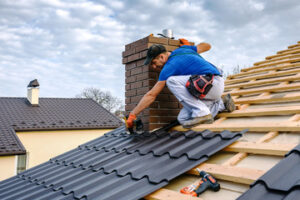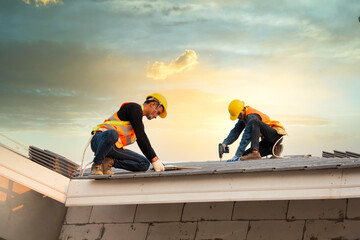Commercial Roof Repair Las Vegas is a crucial part of maintaining the integrity and functionality of business premises. When commercial roofing problems occur, it’s important that the issue is addressed quickly to minimize disruption to daily operations.
Common issues include leaks and structural damage that can affect the interior of a building. Addressing these problems promptly can help prevent the need for costly repairs or replacement.
Commercial roof leaks are a major cause of water damage in commercial buildings. These issues can cause rot, mold growth, and other health hazards for building occupants if not addressed quickly. Commercial roofing repair experts can address the problem by locating the source of the leak and implementing effective repair solutions.
Leaks are often caused by storms, which can dislodge or tear roofing materials and expose the structure to water intrusion. The resulting water damage can lead to costly replacement or repairs. Regular inspections can catch these problems and keep the structure safe from water damage.
Another common cause of commercial roof leaks is damage to the flashing. Flashing is a sheet of metal installed at any breaks, joints, or edges on the commercial roof to prevent leaks. If the flashing becomes damaged, it can cause gaps and leaks in the roof that allow water to enter the building.
Other causes of commercial roof leaks include:
Age and Weathering
Over time, all types of roofing materials degrade, leaving the commercial roof vulnerable to damage and leaks. The deterioration of these materials is usually the result of poor maintenance, which leaves the commercial roof exposed to the elements and unable to properly protect the structure.
Harsh Weather Events
Strong winds, hail, and severe storms can damage or dislodge roofing materials, exposing the building to water intrusion and other damage. Inspecting the commercial roof regularly for damage can help avoid these problems and protect the investment in the structure.
Drainage Problems
Poor drainage or clogged gutters can lead to standing water on the commercial roof, which can weaken the structure and cause leaks. Keep the gutters clear to ensure proper drainage and prevent leaks and other issues.
Damage
A commercial roof protects expensive equipment and keeps building occupants safe. When a damaged roof begins to leak, it can put the entire building at risk and lead to costly downtime for the business. In addition, energy bills can skyrocket if the roof is not repaired in a timely manner. Regular inspections can catch and address problems early, saving the business money in the long run.
Damage to the roof may be caused by a variety of factors. A storm with high winds can rip or dislodge roofing materials, leaving areas exposed and vulnerable. The wind may also carry debris that can puncture or pierce the roof membrane and create further damage. Regular professional inspections following extreme weather can help prevent these issues.
Other causes of commercial roof damage include poor installation and care, normal wear and tear, and other environmental factors. A thorough roof inspection will identify all of the issues, and a licensed roofing contractor can repair or replace damaged materials.
In many cases, specialized roof sealants can be applied to small cracks or leaks as a temporary solution until more permanent repairs can be made. The repair process typically involves removing the damaged materials and installing new ones to restore the integrity of the roof. For structural repairs, the roof beams, joists, or trusses may need to be replaced.
Having gutters and drains that are free of debris can help the roof last longer by preventing water damage. When the gutters become clogged, the standing water will weaken the structure of the roof and increase the likelihood of leaks. Regular cleaning and maintenance of the gutters will minimize the need for commercial roof repairs.
A commercial roof is an integral part of any building, but it is easy to overlook until there are major problems. Damage to the roof can cause costly downtime, increase energy costs, and affect the overall appearance of the building. By catching and repairing any issues in a timely manner, the business can save money and improve the safety of its occupants. Whether the issue is as minor as water spots or as significant as a leaking roof, it should be addressed with urgency.
Misconceptions
When it comes to commercial roof repair, many property owners are armed with misinformation. From believing that a new roof needs no maintenance to thinking a DIY fix will be as good as professional work, misconceptions can put the roof at risk and lead to costly mistakes. By separating fact from fiction, it’s possible to make wiser decisions that protect the roof investment.
One of the most common misconceptions is that commercial roof repairs only need to be performed when the roof is damaged. This is a dangerous mindset to adopt, as commercial roofing systems require regular inspections and preventative maintenance to preserve the waterproofing membrane, prevent leaks and keep insulation in good condition. Taking a proactive approach to commercial roof care will save the building owner money in the long run.
Another common misconception is that commercial roof damage can only be detected by a visual inspection from the ground. While some issues, such as missing shingles, are easy to spot, many commercial roof problems are hidden from view, including roof leaks and deteriorated underlayment. The only way to determine the true state of the commercial roof is to hire a professional roofer for a comprehensive inspection and maintenance plan.
It’s also important to recognize that a commercial roof is designed with slope so that water flows toward the gutters and downspouts, or into drainage systems located within the building. If a roof is flat and does not have enough slope, it can promote mold growth, create ponding water and increase the chances of leaks. A professional roofer can install “crickets” on the surface of the commercial roof to add slope and protect the system from moisture damage.
Another common misconception is that commercial roofs are covered by a warranty. While some warranties do cover certain damages, most are only valid if the building owner follows a proper maintenance plan. When a building owner skips routine inspections and maintenance, the commercial roof will deteriorate faster than expected and cause damage that is not covered by the warranty.
Re-covering
Commercial roof repair is a complex process. Unlike residential roofing, which usually involves patching leaks or sealing cracks, commercial roofs are more complicated and involve larger areas that need to be inspected for structural weakness or other damage. Additionally, because they protect vital business equipment and inventory, any damage can lead to direct financial losses. It is therefore essential that any commercial roof repairs or maintenance is carried out by a professional contractor with experience handling the type of building and materials used.
Commercial buildings are exposed to the elements every day, which means they’re prone to a wide range of environmental issues like structural weakening or water infiltration. The safety and functionality of a business is directly related to the state of the roof, so any damage should be addressed immediately. Regular inspections and prompt commercial roof repair are key to preventing serious problems and costly downtime.
Storm damage and other natural factors can leave behind significant surface damage that requires immediate attention, including missing shingles, cracked or torn sections, and extensive water infiltration. In addition, clogged gutters and drainage systems can cause standing water to erode the roof’s materials over time. A thorough inspection by a licensed professional can identify the source of the problem and recommend the best repair method.
Many products are being promoted as roof re-covers, which appear to be a cost-effective alternative to complete roof replacements. But, although they may seem attractive, re-covers must be carefully considered for each specific project.
Generally, the code requires that any new layer of roof assembly be attached to the existing deck or insulation. It’s also important that any underlying moisture-laden areas are treated before considering a re-cover. A non-destructive evaluation, such as a core sample, can offer valuable insights into the condition of the existing roof deck.
Even if no major structural problems are detected, building owners and facility managers should regularly inspect their flat commercial roofs. They often don’t realize the amount of wear and tear that occurs on their roofs due to normal usage. Whether it is from work boots scuffing the membrane, or the impact of newly installed penetrations such as skylights and HVAC units, even small punctures can result in rapid leaks. In the long run, it is nearly always more cost-effective to repair these minor problems as they occur.

